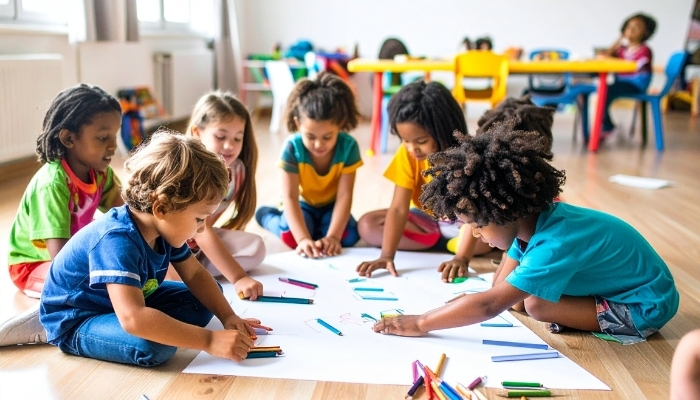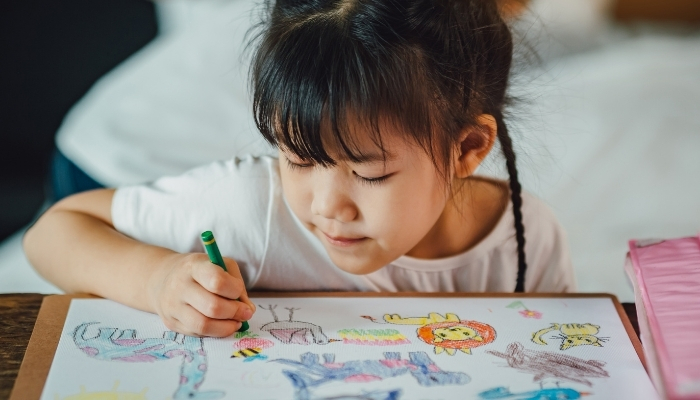Drawing is a skill that helps children develop their creativity and attention to detail. This guide focuses on the basics, making it easy for beginners to start. Through simple steps, kids will learn how to turn basic shapes into more complex drawings, helping them build confidence in their artistic abilities.
As they practice, they’ll also discover the joy of creating something from scratch, without needing advanced tools or techniques. These lessons are designed to make drawing approachable, fun, and a rewarding experience for kids at any skill level.
Key Takeaways
-
Drawing as a Developmental Tool: Learning to draw not only sparks creativity but also improves fine motor skills, cognitive development, and emotional expression in children.
-
Foundational Techniques: Focusing on simple exercises like line drawing, shape formation, and shading helps children build the skills needed for more advanced work.
-
Warm-Up Exercises are Crucial: Activities like drawing lines, shapes, and scribbling prepare children for more detailed work, improving hand-eye coordination and creativity.
-
Understanding Pressure Techniques: Light and heavy pressure techniques teach children how to add depth and texture to their drawings, giving them more control over shading.
-
Mastering Contour and Gesture Drawing: These techniques help children understand form and movement, improving their observational skills and ability to express what they see.
What are the Benefits of Learning the Basics of Drawing?
Introducing drawing to children offers more than just a creative outlet. It serves as a foundational skill that supports various aspects of their development:

-
Improved Fine Motor Skills: Engaging in drawing activities helps children develop the small muscle movements necessary for tasks like writing and buttoning clothes.
-
Cognitive Development: Drawing encourages children to observe their surroundings closely, improving their attention to detail and spatial awareness.
-
Emotional Expression: Through drawing, children can express feelings and ideas that they might find difficult to articulate with words.
-
Boosted Confidence: Completing a drawing provides a sense of accomplishment and reinforces self-esteem, as does working on creative projects.
-
Preparation for Writing: The act of drawing lays the groundwork for writing skills, as it involves similar hand movements and cognitive processes.
5 Key Steps Every Beginner Should Follow to Learn the Basics of Drawing
To get started with drawing, beginners should focus on mastering fundamental techniques such as line work, shading, and basic shapes. Help your child practice sketching everyday objects and observe the work of artists to build confidence and develop skills.

Step 1: Warm-up Exercises
Warm-up exercises help prepare your child’s hands and mind for drawing and improve hand-eye coordination, making it easier to draw with greater control and precision. Simple exercises like drawing straight and curved lines build the foundation for more complex drawings.
To make the process even more enjoyable, try incorporating light activities like freehand scribbling or tracing simple patterns, which allow children to loosen up and engage their imagination without the pressure of creating perfect results.
Warm-Up Activities
-
Line Drawing: Have children practice drawing straight and curved lines. This can be done by following dotted lines or freehand.
-
Shape Formation: Encourage joy of drawing with shapes like circles, squares, and triangles. This helps in building the foundation for more complex drawings.
-
Scribbling & Doodling: Allow children to freely scribble or doodle around the page. This helps loosen up their hand muscles and stimulates their creative flow.
-
Dot & Stipple Practice: Introduce them to creating dots or stipples on paper, focusing on pattern-making and control.
-
Hatching & Zig-Zags: Encourage practicing hatching (creating parallel lines) or drawing zig-zags. These exercises help children gain better control of their hand movements and create interesting textures.
Step 2: Starting with Basic Shapes
Introducing children to learning basic shapes is a crucial step in their artistic development. By focusing on simple forms like circles, squares, triangles, and rectangles, children can learn to recognise and replicate these shapes, forming the foundation for more complex drawings.
Understanding basic shapes aids in spatial awareness and visual perception, allowing children to better interpret and interact with the world around them.
Warm-Up Activities
-
Tracing: Provide children with printed outlines of basic shapes like circles, triangles, and encourage them to trace over them. This activity develops control over hand movements.
-
Construction: Use materials like playdough or clay to form basic shapes. This tactile approach reinforces the concept of shapes and sensory learning.
-
Collages: Cut out various shapes from coloured paper and have children arrange and glue them onto a larger sheet to create a picture or pattern. This will promote creativity and understanding of how shapes can fit together.
-
Walks: Take children on a walk around the neighbourhood or home, encouraging them to identify and name shapes they see in everyday objects, such as windows (rectangles) or road signs (octagons).
-
Art Projects: Incorporate shapes into art projects, like creating a robot using squares and rectangles or a house using triangles and squares. This way, children can apply their knowledge in a fun and imaginative way.
Step 3: Light and Heavy Pressure Techniques
The concept of varying pencil pressure is an essential step in their artistic development, as it helps the child learn to control the intensity of their strokes, enhancing their ability to create depth, texture, and dimension in their drawings.
Understanding how to apply different pressures allows children to experiment with shading and detailing. Moreover, mastering this technique gives them a sense of accomplishment as children see their ability to manipulate their drawing tools.
Warm-Up Activities
-
Pressure Variations: Encourage children to draw the same shape or line multiple times, each with varying pressure. For example, drawing a circle lightly, then with medium pressure, and finally with heavy pressure.
-
Shading Practice: Provide a simple object or shape and ask children to shade it using different pressures. With light and heavy pressure techniques, they will learn about gradient effects, which teach them about light and shadow.
-
Texture Exploration: Introduce textures like hatching, cross-hatching, and stippling. Have children practice these techniques with varying pressures, like light pressure for soft textures and heavy pressure for bold, defined lines.
-
Drawing on Different Surfaces: Allow children to draw on various materials, such as plain paper, textured paper, or even sandpaper. Different surfaces can affect how pressure is applied and can lead to unique artistic outcomes.
-
Interactive Games: Turn pressure practice into a game by challenging children to draw lines or shapes with specific pressure requirements. For example, "Draw a line as light as a feather" or "Create a dark line like a thunderstorm."
Step 4: Contour and Gesture Drawing
Contour drawing focuses on capturing the edges and outlines of objects, increasing attention to detail, and hand-eye coordination. Gesture drawing, on the other hand, emphasises the fluidity and movement of subjects, encouraging children to express the essence of what they see.
Together, these methods help children move beyond symbolic representations nd get a deeper understanding of form, structure, and motion in their artwork.
Warm-Up Activities
-
Blind Contour Drawing: Encourage children to draw an object without looking at their paper, focusing solely on the subject. This exercise develops keen observation skills.
-
Continuous Line Drawing: Having children draw an object using a single, unbroken line promotes fluidity and helps them perceive the subject as a whole.
-
Drawing with Timed Poses: Set a timer for short intervals (e.g., 30 seconds to 2 minutes) and ask children to quickly sketch the movement or pose of a subject.
-
Drawing from Life: Arrange for children to observe a live subject, such as a pet or a family member, and practice contour and gesture drawing.
-
Drawing with Music: Play different types of music and have children draw the movements or emotions the music evokes. This creative exercise links auditory stimuli with visual expression.
Also Read: Top Affordable Interactive Online Classes For Kids
Step 5: Adding Details and Shading
Adding details and shading is another creative step in their artistic journey, as it increases the depth and realism of their drawings and cultivates patience and attention to detail. By learning to observe light sources and how they affect objects, children develop a deeper understanding of the world around them. Additionally, mastering shading techniques instills fine motor skills and controlled pencil movements.
Warm-Up Activities
-
Layering Dark Tones: Encourage children to gradually build up darker tones by layering the shading. Instead of pressing hard with the pencil right away, they should start lightly and use multiple layers to achieve depth.
-
Using an Eraser to Lift Highlights: Incorporate the use of an eraser to lift off highlights from the shaded areas. This technique adds contrast, making the drawing more dynamic and giving life to lighter areas.
-
Hatching and Cross-Hatching: Teach children to use parallel lines (hatching) to create texture and shadow. Once they are comfortable with hatching, introduce cross-hatching and drawing lines in the opposite direction.
-
Tonal Reference Points: Ask children to identify the brightest highlight and the darkest shadow on their subject and use these points as a tonal reference. This will help them understand how to balance the drawing's overall tone.
-
Final Detail Work: Once the basic tones are in place, children can begin adding finer details. For example, the shading texture of skin, hair, or clothing.
How FunFox Supports Children in Developing Skills
FunFox offers structured, engaging online classes that focus on building foundational reading and writing skills. Through small group sessions, children receive personalised attention, ensuring they grasp essential language techniques and concepts.

Key Ways FunFox Supports Literacy Development:
-
Step-by-Step Guidance: Each session provides clear instructions, helping children understand and apply fundamental writing and reading techniques.
-
Personalised Attention: Small class sizes ensure that each child receives individual support, instilling a conducive learning environment.
-
Building Core Skills: Children practice writing, reading comprehension, and vocabulary, developing stronger literacy skills.
-
Interactive Learning: FunFox’s tools and resources keep students engaged while reinforcing reading and writing techniques.
-
Confidence Boost: Regular feedback and hands-on practice help children gain confidence in their reading and writing abilities.
Conclusion
Improving drawing skills is a journey that requires patience and practice. While the early stages may feel challenging, it’s important to remember that consistent effort leads to progress.
Encouraging regular practice, starting with simple exercises like drawing continuous lines, and gradually moving to more complex subjects, helps build confidence and control. It’s also important to push beyond comfort zones and focus on areas that may seem difficult at first.
The process should remain fun and engaging, allowing for creativity to flow naturally. Ultimately, with persistence and dedication, every drawing becomes a step forward, leading to greater skill and enjoyment in the art of sketching.
FAQs
1. What are the five rules of drawing?
The five fundamental rules of drawing include understanding proportion, practicing perspective, mastering shading, using proper line techniques, and studying composition. These rules help create accurate and balanced drawings.
2. What is the difference between drawing and sketching?
Drawing typically refers to a more detailed, polished work of art, while sketching is a quick, loose way to capture ideas or concepts without focusing on precision or refinement.
3. What type of art is sketching?
Sketching is considered a form of preliminary art used to quickly capture an idea, scene, or concept, often serving as the foundation for more detailed drawings or paintings.
4. Which type of pencil is used in sketching?
For sketching, artists often use pencils ranging from H (hard) to B (soft). Softer pencils like 2B to 6B are preferred for their darker lines and ease of shading, while harder pencils are used for lighter, finer lines.
5. What drawing tools are best for beginners?
For beginners, basic tools like graphite pencils (H, 2B), erasers, a sketchbook, and blending stumps work well. These tools are versatile and allow easy practice of essential drawing techniques.















